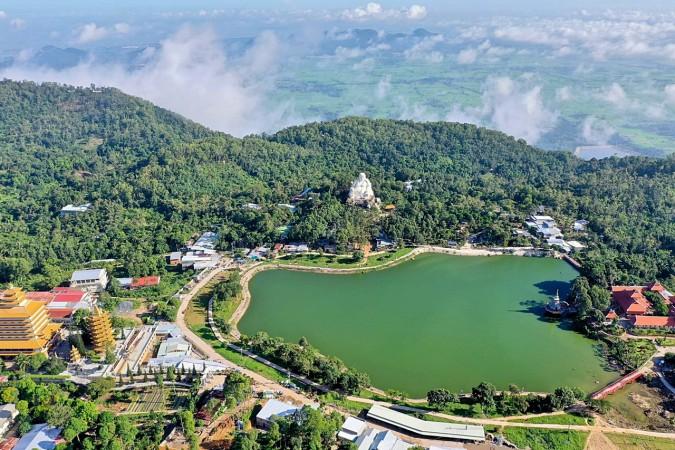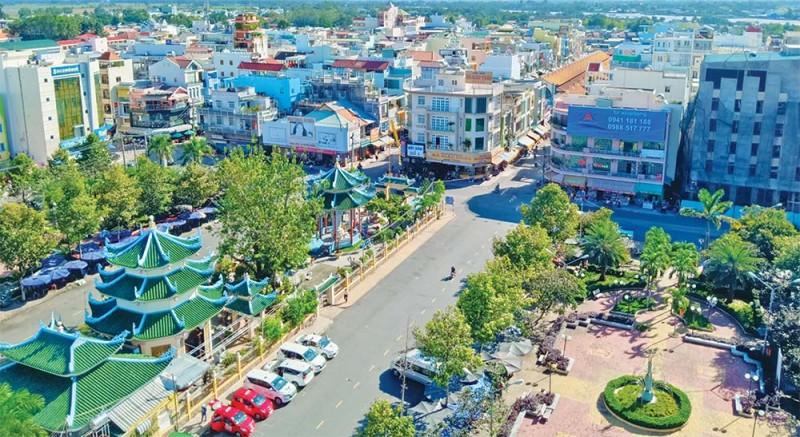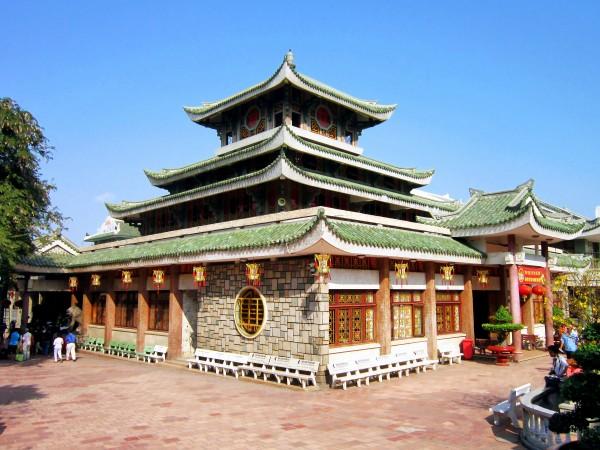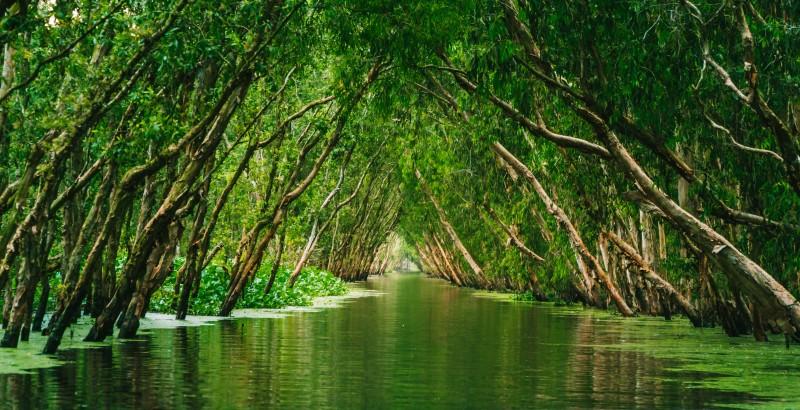Explore Chau Doc - South Vietnam Travel, Asia
Nestled in the far west of An Giang Province, Châu Đốc is where the Hậu River bends toward the Cambodian border. This riverside city is a blend of cultures, faiths, and flavors. Here, Vietnamese, Khmer, Cham, and Chinese communities live side by side, shaping a rich tapestry of daily life. For travelers, Châu Đốc offers more than stunning river views. It’s a city of floating markets, sacred temples, and bustling border trade.
Population: Approximately 100,000 in 2019.
Economy: Chau Doc’s economy thrives on cross-border trade, aquaculture, and agriculture, especially rice and fish farming. Tourism also plays a key role, fueled by its cultural diversity and proximity to Cambodia.
Landmarks: Famous for the Sam Mountain, Ba Chua Xu Temple, and the Chau Doc Floating Market.
Vietnam

Overview of Chau Doc
History & Cultural Influence
Chau Doc’s history is one of crossroads and confluence. Once a key outpost in the Nguyen Dynasty’s expansion, it became a strategic link between Vietnam and Cambodia. Over centuries, Cham Muslims, Khmer Buddhists, and Chinese merchants settled here, each leaving their mark. This multicultural heritage is visible in the city’s pagodas, mosques, and stilt houses along the river. Chau Doc is not just a museum of the past but a living showcase of cultures evolving together.
Interaction with The Locals
To understand Chau Doc, spend time with its people. Locals greet visitors with easy smiles and stories of river life. At dawn, the Chau Doc Floating Market buzzes with boats trading fish, fruits, and vegetables. Vendors often invite travelers to taste freshly cut pineapple or hot coffee brewed on deck. In the Cham villages, families welcome guests into their stilt homes, sharing tea and insights into their daily traditions. Farmers in nearby hamlets might let you try rowing a sampan or casting a fishing net.

Top Attractions in Chau Doc
Sam Mountain
Rising 284 meters above the rice fields, Sam Mountain is both a pilgrimage site and a scenic lookout. Its slopes are dotted with temples, shrines, and pagodas. At sunrise or sunset, the view stretches across the Mekong Delta and into Cambodia. Pilgrims climb to visit the Ba Chua Xu Temple, a revered spiritual site.
Ba Chua Xu Temple
This temple is the spiritual heart of Chua Doc. Dedicated to the Lady of the Realm, it draws thousands during the Ba Chua Xu Festival each spring. Incense fills the air as worshippers offer flowers, fruits, and prayers for prosperity and protection.
Chau Doc Floating Market
Set on the Hau River, this early-morning market is a hub of river trade. Wooden boats carry everything from tropical fruits to fresh fish. It’s also the best place to watch local commerce in action and taste breakfast right on the water.
Tra Su Cajuput Forest
A short ride from the city, Tra Su is a vast wetland covered in emerald-green duckweed. Wooden boats glide through canals lined with cajuput trees, home to hundreds of bird species. It’s a paradise for birdwatchers and nature photographers.
Cham Villages
Located on the riverbanks, these villages are home to the Cham Muslim community. Visitors can explore wooden stilt houses, visit mosques, and watch traditional weaving on wooden looms. Local markets sell colorful fabrics and handmade crafts.
Tay An Pagoda
With its pastel facade and unique architectural blend of Vietnamese, Indian, and Islamic styles, Tay An Pagoda is both a religious and architectural landmark. The peaceful gardens and intricate statues make it a serene stop on any itinerary.

Must-Try Dishes in Chau Doc
- Chau Doc Fish Noodle Soup: A signature breakfast, this dish features turmeric-infused broth, tender snakehead fish, and fresh herbs. The golden hue comes from turmeric and annatto oil, while banana flower, bean sprouts, and basil bring crunch and fragrance.
- Chau Doc Fermented Fish Paste: This pungent yet addictive specialty defines the city’s culinary identity. Made from freshwater fish fermented with salt and spices, this specialty can be enjoyed as a dipping sauce, soup base, or stir-fried with vegetables.
- Seven-Course Beef Feast: A feast for meat lovers, bò bảy món features beef prepared in seven ways, from grilled lemongrass skewers and beef wrapped in betel leaves to tangy beef salad and simmering beef hotpot. Served with rice paper, herbs, and dipping sauces, it’s perfect for sharing.
- Bitter Leaf Salad: A Khmer-influenced dish, this salad combines the subtle bitterness of neem leaves with grilled fish or dried shrimp. Dressed in palm sugar and lime, it delivers a balanced, refreshing taste that’s both unique and memorable.
- Fermented Fish Hotpot: An aromatic hotpot featuring fermented fish paste as its base, this dish is packed with vegetables like water spinach, eggplant, and okra, along with fish or seafood.
- Charcoal-Grilled Snakehead Fish: A rustic countryside classic, whole snakehead fish is grilled over open flames, wrapped in banana leaves, and served with rice paper, herbs, and a tamarind dipping sauce. The smoky aroma and tender flesh make it irresistible.
- Chau Doc Pancake: Thin, crispy pancakes filled with shrimp, pork, bean sprouts, and mung beans, served with fresh greens and fish sauce. Chau Doc’s version often uses river shrimp for extra sweetness.
- Grilled Sticky Rice with Banana: A beloved street snack, ripe bananas are wrapped in sticky rice, grilled until golden, and served with coconut cream and roasted peanuts.
- Palm Sugar Dessert: Made from local sugar palms, this dessert combines chewy tapioca pearls, fragrant palm sugar syrup, and creamy coconut milk. It’s a taste that instantly evokes the Mekong Delta.

Festivals & Local Celebrations
Ba Chua Xu Festival
The largest and most famous celebration in Chau Doc, held annually from the 23rd to 27th day of the fourth lunar month (April–May). Pilgrims from across Vietnam flock to Ba Chua Xu Temple at the foot of Sam Mountain to pray for health, prosperity, and protection. The festival features solemn rituals, processions, incense offerings, and traditional music performances. Streets overflow with food stalls, flower vendors, and handicrafts, creating a lively, almost carnival-like atmosphere.
Ok Om Bok Festival (Moon Worship Festival)
Celebrated by the Khmer community in late October or early November (15th day of the tenth lunar month), this festival honors the moon deity for a good harvest. Locals gather at riverbanks to release hoa đăng (lotus-shaped lanterns) onto the water, symbolizing wishes and gratitude. In nearby Khmer villages, traditional games and folk dances fill the night.
Ramadan & Eid al-Fitr in Cham Villages
For the Cham Muslim community, Ramadan is a month of spiritual reflection, fasting, and prayer. At its conclusion, Eid al-Fitr is marked with communal prayers at mosques, festive meals, and open-door hospitality. Visitors who are respectfully dressed and invited by locals can experience the warmth of Cham traditions.

What to Do in Chau Doc
- River Cruises on the Hau River: Board a small wooden boat or sampan to glide along the Hậu River. Morning cruises pass floating houses, fishing nets, and trading boats, while sunset trips reveal the golden hues of the delta.
- Cycling Through Countryside & Border Villages: Rent a bicycle and pedal past emerald rice paddies, lotus ponds, and stilt houses. Routes often lead toward the Cambodian border, offering glimpses of rural life and friendly greetings from farmers.
- Birdwatching in Tra Su Cajuput Forest: Join an eco-tour to spot herons, storks, and kingfishers in their natural habitat. The best time for birdwatching is early morning or late afternoon, when the forest is most active.
- Temple & Pagoda Hopping: Spend a day visiting Ba Chua Xu Temple, Tay An Pagoda, and other sacred sites. Each place offers insights into the city’s blended spiritual heritage.
Shopping in Chau Doc
- Chau DocMarket: Located in the city center, this bustling market is famous for Chau Doc fermented fish paste, dried fish, and freshwater produce. The air is filled with the aroma of herbs and spices, and stalls overflow with tropical fruits and local snacks.
- Mekong Delta Handicrafts: Pick up woven mats, baskets, and silk scarves made by Cham artisans in nearby villages. These handmade items carry cultural value and make meaningful souvenirs.
- Cambodian Border Goods: Due to its proximity to Cambodia, Chau Doc offers imported spices, teas, and packaged snacks not easily found elsewhere in Vietnam. Many traders bring them directly from Phnom Penh.
- Night Market Finds: In the evenings, small night markets set up near the river, selling casual clothing, trinkets, and affordable street food. It’s the perfect place to shop while enjoying local bites.

Weather in Chau Doc: Best Time to Visit
Dry Season in Chau Doc (December – April)
The dry season is the best time to visit, with plenty of sunshine and average daytime temperatures around 28–32°C (82–90°F). Clear skies make it ideal for river cruises, cycling tours, and festival visits like the Ba Chua Xu Festival.
Wet Season in Chau Doc (May – November)
During the wet season, short but heavy rains nourish the region’s lush greenery. Temperatures remain warm, averaging 27–30°C (81–86°F). This is the best period to witness the flooded rice fields, floating markets, and Tra Su Cajuput Forest at their most vibrant. Bring a lightweight raincoat and waterproof footwear if you plan to explore by boat.

Essential Travel Information
Getting Around Chau Doc
- Boats & Ferries: Chau Doc sits on the Hau River, making boats and ferries a scenic way to reach floating markets, Cham villages, and nearby wetlands. Private sampan tours offer more flexibility for photography and sightseeing.
- Cycling & Motorbike Rentals: Bicycles are ideal for exploring rural paths and border villages, while motorbikes give more freedom to reach Sam Mountain, Tra Su Forest, and hidden countryside trails. Helmets are required by law.
- Taxis & Ride-Hailing Apps: Metered taxis are available in the city center. Popular ride-hailing services like Grab operate in the region, offering motorbike and car rides at affordable rates.
- Buses & Minivans: Buses connect Chau Doc with Long Xuyen, Can Tho, and Ho Chi Minh City. Minivans offer faster, more comfortable rides, though they may cost slightly more.
ATM & Banking Services
Most ATMs in Chau Doc are concentrated around the city center, near the Chau Doc Market, bus stations, and main hotels. Major Vietnamese banks operate here, offering services compatible with international cards, including Visa and Mastercard. While Chau Doc is generally safe, avoid withdrawing large amounts in one go and keep your cash in a secure money belt or travel wallet.
Where to Stay in Chau Doc
- Mid-Range Hotels: Three-star hotels in the city center provide comfortable rooms with air-conditioning, Wi-Fi, and breakfast included. Staying here means you’re within walking distance of markets, street food, and ferry docks.
- Luxury & Riverside Resorts: For travelers seeking more comfort, Chau Doc has riverside resorts featuring panoramic views of the Hậu River, swimming pools, and fine dining. Some properties also offer spa services and boat tours directly from their private docks.
- Homestays in Villages: Staying in a Cham or Khmer village homestay gives a deeper cultural experience. You can enjoy home-cooked meals, learn about traditional crafts, and witness daily life up close.
Articles for you

Explore Yala National Park - Sri Lanka Travel, Asia
Tucked away in Sri Lanka’s southeastern corner, Yala National Park is where wild nature meets deep tradition. Known worldwide for its leopard population, the park is also home to elephants, sloth bears, crocodiles, and hundreds of bird species. Beyond wildlife, Yala opens doors to a cultural landscape dotted with ancient temples, Buddhist ruins, and coastal villages. For travelers seeking more than just a safari, Yala offers a chance to explore eco-tourism, local communities, and sacred heritage sites.
Population: The Yala National Park area doesn’t have a human population.
Economy: The economy around Yala National Park thrives on a blend of eco-tourism, agriculture, and local services. Safari tours, eco-lodges, and cultural experiences drive steady income for nearby towns like Tissamaharama and Kataragama, supporting thousands of families.
Landmarks: Famous for Block I of Yala and wildlife encounters, including elephants, sloth bears, crocodiles, and exotic bird species.

Explore Galle - Sri Lanka Travel, Asia
Nestled on Sri Lanka’s southern coastline, Galle is a vibrant city where history meets the sea. Its cobbled streets, colonial architecture, and serene beaches make it a must-visit destination for travelers seeking a blend of culture, adventure, and relaxation. A UNESCO World Heritage site, Galle captivates visitors with its Dutch Fort, bustling markets, and friendly locals. Whether you’re exploring the ramparts at sunset or savoring fresh seafood by the shore, Galle promises an unforgettable journey into Sri Lanka’s heritage.
Population: Approximately 113,000 in 2023.
Economy: Galle’s economy thrives on tourism, trade, and fisheries. The city’s historic fort, colonial architecture, and coastal charm draw thousands of international visitors each year, making tourism its main economic driver. Fishing remains vital for local livelihoods, supplying fresh seafood across the region.
Landmarks: Famous for the Galle Fort, Dutch Reformed Church & Maritime Museum, and Unawatuna Beach.

Explore Bentota - Sri Lanka Travel, Asia
Nestled along Sri Lanka’s southwestern coast, Bentota is a tropical paradise that blends golden beaches, vibrant culture, and thrilling adventures. Famous for its calm waters, luxury resorts, and scenic river estuary, Bentota has become a top destination for travelers seeking both relaxation and authentic experiences. From serene beach walks at sunrise to adrenaline-pumping water sports, this coastal town offers a perfect balance of leisure and exploration. With its proximity to Colombo and Galle, Bentota is easy to reach, making it an ideal stop for both short escapes and extended holidays.
Population: Approximately 37,000 in 2023.
Economy: Bentota’s economy thrives mainly on tourism, which drives local businesses such as hotels, restaurants, and wellness retreats. The town also benefits from fishing, coconut cultivation, and handicrafts like wood carving and batik textiles. Many residents rely on the growing demand for water sports and Ayurvedic treatments, making tourism the backbone of both income and employment in the area.
Landmarks: Famous for Bentota Beach, Bentota River Safari, and Kande Vihara Temple.

Explore Mirissa - Sri Lanka Travel, Asia
Mirissa is a charming coastal town on Sri Lanka’s southern shoreline. Known for its golden beaches, turquoise waters, and vibrant marine life, it has become a must-visit stop for travelers exploring the island. Many come for whale watching, surfing, and sunset views at Coconut Tree Hill, but Mirissa offers much more than postcard beauty. The fishing boats you see anchored by the bay carry generations of stories. Local traditions, delicious cuisine, and a laid-back rhythm of life shape every visitor’s experience.
Population: Approximately 4,700 in 2023.
Economy: Mirissa’s economy is largely shaped by its coastal location. Fishing has long been the backbone of local livelihoods, with generations relying on the Indian Ocean for income. In recent decades, tourism has become the main driver of growth, thanks to whale watching, surfing, and beachside hospitality.
Landmarks: Famous for Mirissa Beach, Coconut Tree Hill, and Parrot Rock Bridge.

Explore Nuwara Eliya - Sri Lanka Travel, Asia
Tucked away in the Central Highlands of Sri Lanka, Nuwara Eliya is often called “Little England”. With its rolling tea plantations, cool misty mornings, and colonial charm, this mountain town feels like a step into another world. Travelers come here to breathe fresh air, walk through flower gardens, sip the finest Ceylon Tea, and enjoy a pace of life far from the island’s busy cities. Whether you’re drawn by scenic landscapes, heritage architecture, or the warmth of its people, Nuwara Eliya is a destination that blends nature, culture, and history in perfect harmony.
Population: Approximately 781,000 in 2023.
Economy: Nuwara Eliya’s economy thrives mainly on tea production, as it sits in the heart of Sri Lanka’s central highlands, famous worldwide for Ceylon Tea. The city also benefits from a growing tourism industry, attracting visitors with its colonial charm, cool climate, and scenic landscapes.
Landmarks: Famous for Gregory Lake, Hakgala Botanical Garden, and Victoria Park.

Explore Sukau - Malaysia Travel, Asia
Nestled on the banks of the Kinabatangan River in Sabah, Malaysian Borneo, Sukau is a destination where wildlife, culture, and conservation come together. Known as one of Asia’s top spots for river safaris and eco-tourism, this quiet village offers a front-row seat to encounters with Bornean orangutans, pygmy elephants, proboscis monkeys, and exotic birdlife.
Population: Approximately 1,400 in 2019.
Economy: Sukau’s economy is shaped by its riverine location and natural resources. Traditionally, the Orang Sungai community relied on fishing, small-scale farming, and forest gathering for their livelihood. Today, the village has shifted toward eco-tourism, with river cruises, jungle trekking, and homestays providing income.
Landmarks: Famous for the Kinabatangan River cruises, Gomantong Caves, and Ox-bow lakes and wetlands.
